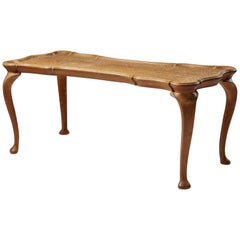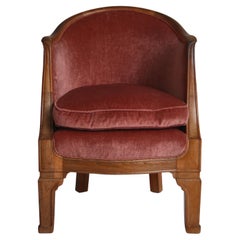Occasional Table Attributed To Frits Henningsen
Vintage 1940s Swedish Scandinavian Modern Coffee and Cocktail Tables
Oak
People Also Browsed
Vintage 1950s Danish Console Tables
Lacquer
Vintage 1920s Danish Baroque Revival Lounge Chairs
Velvet, Rosewood
Vintage 1950s Danish Mid-Century Modern Home Accents
Cane, Beech
Vintage 1930s Danish Scandinavian Modern Armchairs
Leather, Mahogany
Mid-20th Century Danish Scandinavian Modern Sofas
Oak
Vintage 1950s European Scandinavian Modern Living Room Sets
Leather
Vintage 1940s Scandinavian Modern Dining Room Chairs
Wood, Leather
Frits Henningsen for sale on 1stDibs
Danish cabinetmaker Frits Henningsen never compromised on quality. His furniture is known for its impeccable craftsmanship, and unlike many designers of his day, Henningsen — a dogged perfectionist — rarely permitted any of his pieces to be built outside of his own workshop. Each of his elegant low-profile tables, chairs and sofas feature the clean lines and graceful curves typically associated with vintage mid-century modern and Scandinavian modern furniture.
Henningsen was born in 1889 and apprenticed as a cabinetmaker in the early 1900s. He was mentored by the well-known and respected cabinetmaker I.P. Mørck and completed his apprenticeship at the age of 22.
Henningsen also studied at the Royal Danish Academy of Fine Arts, where one of his teachers was legendary furniture designer Kaare Klint, who is frequently called the father of Danish modernism. Henningsen saw Klint as a friendly rival, which motivated him to refine his craftsmanship and technique.
Henningsen traveled throughout Germany, France, and Great Britain to gather knowledge, experience and inspiration. He returned to Copenhagen in 1915 and set up a furniture store and workshop to create and sell his own designs. He also developed relationships with Rud Rasmussen and Carl Hansen & Søn, the only furniture manufacturers he trusted to produce his designs.
Bucking the angular and geometric furniture trends of the time, Henningsen embraced fluid and organic forms. Much of his inspiration came from the Rococo, French Empire and British 17th-century styles he encountered on his travels. The 1930 Heritage chair is a prime example of these influences. It features soft, curving lines and has a sophisticated appeal.
Another piece that showcases Henningsen’s style and craftsmanship is the 1952 Signature chair. A striking work that features an inviting curved seat atop sinuous carved wood legs, the Signature chair was his last design.
The straightforward and timeless style of Henningsen furniture continues to enjoy popularity today. In fact, in 2015, Carl Hansen & Son reissued the iconic Signature chair.
On 1stDibs, find vintage Frits Henningsen seating, side tables and cabinets on 1stDibs.
A Close Look at scandinavian-modern Furniture
Scandinavian modernism is perhaps the warmest and most organic iteration of modernist design. The work of the designers associated with vintage Scandinavian modern furniture was founded on centuries-old beliefs in both quality craftsmanship and the ideal that beauty should enhance even the humblest accessories of daily life.
ORIGINS OF SCANDINAVIAN MODERN FURNITURE DESIGN
- Emerged in the 1930s
- Originated primarily in Denmark, Sweden and Finland
- Introduced in the United States in mid-20th century
- Informed by the Bauhaus and modernism; influenced American mid-century modernism
CHARACTERISTICS OF SCANDINAVIAN MODERN FURNITURE DESIGN
- Bold, clean lines and simple, sturdy symmetries
- Use of natural materials — native woods such as pine, ash and beech
- Open, airy spaces
- Promotion of functionality
- Emphasis on craftsmanship; rooted in cabinetry profession and traditional construction techniques
- Minimal ornamentation (little to no embellishment)
- A neutral or light color palette owing to prominence of light woods
SCANDINAVIAN MODERN FURNITURE DESIGNERS TO KNOW
- Alvar Aalto
- Hans Wegner
- Kaare Klint
- Arne Jacobsen
- Greta Magnusson Grossman
- Finn Juhl
- Arne Vodder
- Verner Panton
ICONIC SCANDINAVIAN MODERN FURNITURE DESIGNS
VINTAGE SCANDINAVIAN MODERN FURNITURE ON 1STDIBS
The gentle, organic contours that are typical of Scandinavian design appear in the furnishings and decor created by Danish, Finnish and Swedish designers not as a stylistic gesture, but rather as a practical, ergonomic — and, as importantly, elegant — response to the human form.
Each nation produced exceptional talents in all areas of the applied arts, yet each had its forté. Sweden was home to Greta Magnusson Grossman and Bruno Mathsson — creators of the classic Grasshopper lighting series and Berlin daybed, respectively — but the country excelled most notably at ceramics. In the 1920s at the great Gustavsberg porcelain manufactory, Wilhelm Kåge introduced pieces in the Scandinavian style based on influences from folklore to Cubism; his skills were passed on to his versatile and inspired pupils Berndt Friberg and Stig Lindberg.
Likewise, Finland produced a truly ingenious Scandinavian modern furniture designer in the architect Alvar Aalto, a master at melding function and artistic form in works like the Paimio chair, created in collaboration with his first wife, Aino. Yet Finnish glassware was pre-eminent, crafted in expressive, sculptural designs by Tapio Wirkkala and Timo Sarpaneva.
The Danes excelled at chairs. Hans Wegner and Arne Jacobsen were exemplars of the country’s facility with wood, particularly teak.
Wegner created such iconic pieces as the Round chair and the Wishbone chair; Jacobsen — while the revolutionary architect and furniture innovator produced the best-selling plywood Ant chair — designed two classic upholstered pieces of the 1950s: the Swan chair and Egg chair. The list of great Danes could go on and on, including Finn Juhl, a stylistic maverick and maker of the bold Chieftain chair; Poul Kjaerholm, with his lean metal-and-rattan aesthetic; and Verner Panton, who introduced a vibrant Pop note into international design.
Today, decades after their heyday, the prolific, ever-evolving Scandinavian modernists continue to amaze and delight, and interior designers all over the world use their pieces to bring warmth to any given space.
On 1stDibs, you will note both instantly recognizable vintage Scandinavian modern chairs, sofas, rugs and tables — those that have earned iconic status over time — and many new discoveries.
Finding the Right card-tables-tea-tables for You
Today, the phrase “card tables” might evoke the image of common plastic tables covered in felt, but historically these tables were statement pieces that invited merriment and were made of mahogany, walnut or other fine woods. Today, antique and vintage card tables and tea tables can enliven a space and encourage spirited competition in your home.
Card tables originated in England in the late 17th century, and during this time, as well as the 18th century, game tables in general became quite popular. We refer to early versions of card tables as antique Regency card tables because the Prince of Wales ruled England during the period and his official title was Regent. Back then, these furnishings were typically small, rectangular tables outfitted with hinged tops so that they could be opened to reveal a playing surface. Ornamental flourishes of the era might have included an integration of fine velvet or needlepoint as lining for the table’s surface. For furniture makers, wide adoption of a dense woven green material called baize for table covering — similar to felt but stronger — occurred during the early 1700s.
Tea became widely affordable during the early 1800s in England, and tea time exploded in popularity and involved large tea sets — especially during the Victorian era — as well as small, well-crafted tea tables. Your beverage was paired with petite baked goods, and the tea table would be home to teacups, saucers, a milk pot and other items. While tea tables are similar in design to card tables, the focus is more on presentation. Georgian card tables and tea tables — furniture made during the reign of England’s three Georges — were especially ornate. Some featured intricately carved design elements on each side and stood on elegantly curved legs. After all, tea time became a sacred ritual that society women dressed up for. It was a time to pause, reflect and sip a comforting beverage.
When no guests were visiting to enjoy tea or play games, owners could fold down both card tables and tea tables to their smaller size and tuck them away into a corner of the room.
Antique and vintage card tables and tea tables can make a lovely addition to any living room, entertainment room or game room. Find yours on 1stDibs.


